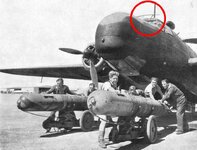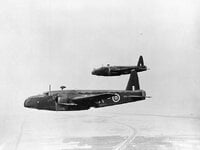Hi
There are many examples of simple bomb and torpedo sights often designed by squadron aircrew. They mostly are variations of a rifle with a foresight and backsight to assist the pilot and sometimes the 2nd pilot to allow approaches from both sides. I am attaching two pictures of Wellington torpedo-bombers, both in the Middle East, possibly both 38 Squadron. One has what might be a typical sighting aid being two small spikes in front of the cockpit. The other has a more complicated gadget seemingly covering quite a wide arc. Is the fancy device a sighting aid and if so is more known about it? The alternative suggestion is that it is a windscreen spray to remove salt deposits from flying at low level. Thanks
There are many examples of simple bomb and torpedo sights often designed by squadron aircrew. They mostly are variations of a rifle with a foresight and backsight to assist the pilot and sometimes the 2nd pilot to allow approaches from both sides. I am attaching two pictures of Wellington torpedo-bombers, both in the Middle East, possibly both 38 Squadron. One has what might be a typical sighting aid being two small spikes in front of the cockpit. The other has a more complicated gadget seemingly covering quite a wide arc. Is the fancy device a sighting aid and if so is more known about it? The alternative suggestion is that it is a windscreen spray to remove salt deposits from flying at low level. Thanks


